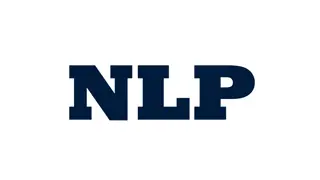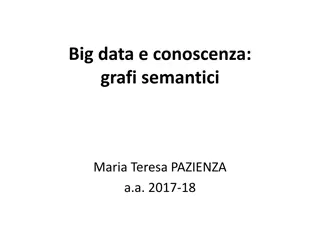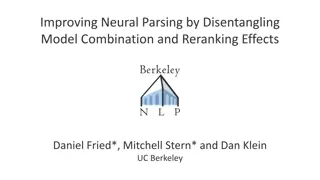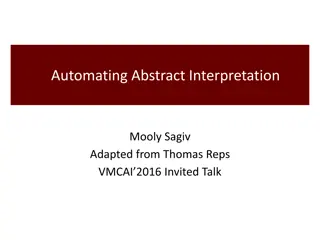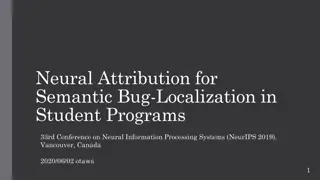LR Parsing and State Merging Techniques
The content discusses LR parsing techniques such as LR(0), SLR(1), LR(1), LALR(1), and their advantages in resolving shift-reduce and reduce-reduce conflicts. It also delves into state merging in LR parsing, highlighting how merging states can introduce conflicts and affect error detection in parser
2 views • 29 slides
Artificial Neural Networks From Scratch
Learn how to build artificial neural networks from scratch, focusing on multi-level feedforward networks like multi-level perceptrons. Discover how neural networks function, including training large networks in parallel and distributed systems, and grasp concepts such as learning non-linear function
3 views • 33 slides
Semantic Roles in Sentence Structure
Semanticists analyze sentences based on semantic structure rather than traditional syntactic terms like subject and object. Instead, they use semantic terms such as Agent, External causer, Instrument, Affected, Recipient, and Locative. These terms help describe how people and things participate in r
1 views • 26 slides
Neural Quantum States and Symmetries in Quantum Mechanics
This article delves into the intricacies of anti-symmetrized neural quantum states and the application of neural networks in solving for the ground-state wave function of atomic nuclei. It discusses the setup using the Rayleigh-Ritz variational principle, neural quantum states (NQSs), variational pa
3 views • 15 slides
Introduction to Neural Networks in IBM SPSS Modeler 14.2
This presentation provides an introduction to neural networks in IBM SPSS Modeler 14.2. It covers the concepts of directed data mining using neural networks, the structure of neural networks, terms associated with neural networks, and the process of inputs and outputs in neural network models. The d
3 views • 18 slides
Dynamic Oracle Training in Constituency Parsing
Policy gradient serves as a proxy for dynamic oracles in constituency parsing, helping to improve parsing accuracy by supervising each state with an expert policy. When dynamic oracles are not available, reinforcement learning can be used as an alternative to achieve better results in various natura
0 views • 20 slides
Shift-Reduce Parsing Example in Mr. Lupoli's F2012
This example explains shift-reduce parsing by tracing the input to the original start symbol. It demonstrates how shifting and reducing operations work in parsing mechanics, using the given original production and syntax rules for matching and reduction steps.
0 views • 16 slides
Semantic Web Technologies and Knowledge Representation Overview
Semantic Web technologies such as RDF, RDFS, OWL, and SPARQL form the basis of a web of data designed for machine understanding. Knowledge representation languages play a crucial role in AI, with Semantic Web languages like OWL leading the current generation. Contrasting database and knowledge base
1 views • 50 slides
Multimodal Semantic Indexing for Image Retrieval at IIIT Hyderabad
This research delves into multimodal semantic indexing methods for image retrieval, focusing on extending Latent Semantic Indexing (LSI) and probabilistic LSI to a multi-modal setting. Contributions include the refinement of graph models and partitioning algorithms to enhance image retrieval from tr
1 views • 28 slides
Advanced Parsing Techniques for NLP Evaluation
Delve into the realm of advanced parsing with a focus on evaluating natural language processing models. Learn about tree comparison, evaluation measures like Precision and Recall, and the use of corpora like Penn Treebank for standardized parsing evaluation. Gain insights on how to assess parser per
0 views • 50 slides
Top-Down Parsing in Context-Free Syntax
Context-free syntax expressed with context-free grammar plays a key role in top-down parsing. This parsing method involves constructing parse trees from the root down to match an input string by selecting the right productions guided by the input. Recursive-descent parsing, Rule Sentential Forms, an
0 views • 17 slides
Revisiting Semantic Feature Analysis: A Classic Therapy Technique
Aphasia often involves semantic breakdown, and Semantic Feature Analysis (SFA) is a foundational technique for various treatments addressing semantic impairments. This presentation explores the effectiveness of SFA in improving naming, generalization to spontaneous speech, and treatment goals beyond
0 views • 16 slides
Exploring Fast & Accurate Parsing With Learning to Prune
In this informative content, the concept of learning to prune is discussed in the context of exploring the frontier of fast and accurate parsing. It delves into the optimization tradeoff between runtime and accuracy in end-to-end systems, showcasing a Pareto frontier of different system performances
0 views • 42 slides
Introduction to NLP Parsing Techniques and Algorithms
Delve into the world of Natural Language Processing (NLP) with a focus on parsing techniques like Cocke-Kasami-Younger (CKY) and Chart Parsing. Explore challenges such as left recursion and dynamic programming in NLP, along with detailed examples and explanations of the CKY Algorithm.
0 views • 42 slides
Enhancing Name and Address Parsing for Data Standardization
Explore the project focused on improving the quality of name and address parsing using active learning methods at the University of Arkansas. Learn about the importance of parsing, entity resolution, and the token pattern approach in standardizing and processing unstructured addresses. Discover the
1 views • 11 slides
Ensembling Diverse Approaches to Question Answering
Diverse types of question answering approaches include factoid querying, compositional querying of structured databases/knowledge graphs, reading comprehension, and visual question answering. Limitations of factoid question answering are also discussed, highlighting the need for specific queries and
1 views • 28 slides
Annotating Semantic Issues in Translation for Students
This chapter delves into semantic issues in translation, aiming to assist students in annotating their translations from a semantic viewpoint. It emphasizes using semantic information to aid in translating data accurately while maintaining communicative effectiveness. The story discussed highlights
0 views • 19 slides
Bottom-Up and Top-Down Parsing in Computer Science
Bottom-up parsing and top-down parsing are two essential strategies in computer science for analyzing and processing programming languages. Bottom-up parsing involves constructing a parse tree starting from the leaves and moving towards the root, while top-down parsing begins at the root and grows t
0 views • 29 slides
Semantic Technologies for Data Management and Knowledge Extraction
An exploration of how semantic technologies facilitate data management, knowledge extraction, and understanding in the realm of big data. Topics covered include semantic graphs, content information extraction, and the impact of semantic models on enhancing data value and relationships. The importanc
2 views • 38 slides
Requirements for Semantic Biobanks and Global Biobank Data Retrieval
Explore the critical aspects of semantic interoperability in biobanking, highlighting the need for formal ontologies, comprehensive annotations, and model of meaning data. The (Generalized) Biomedical Retrieval Scenario underscores the importance of effective resource retrieval based on content-base
0 views • 16 slides
Advances in Neural Semantic Parsing
Delve into the realm of neural semantic parsing with a focus on data recombination techniques, traditional parsers, and the shift towards domain-general models. Explore the application of sequence-to-sequence models and attention-based neural frameworks in semantic parsing tasks. Discover the evolvi
0 views • 67 slides
Improving Neural Parsing by Disentangling Model Combination and Reranking Effects
This paper by Daniel Fried, Mitchell Stern, and Dan Klein from UC Berkeley focuses on enhancing neural parsing by untangling the impact of model combination and reranking effects. The study delves into innovative approaches to optimize parsing performance through disentanglement strategies.
1 views • 18 slides
Flexible Semantic Mapping Framework for Improved Semantic Interoperability
This framework Proposal aims to enhance semantic interoperability by introducing a pragmatic and flexible approach to semantic mapping. It addresses current fragmented practices, offering tools for end-users to create, reuse, and extend mappings. With a focus on FAIR principles, the framework also e
0 views • 6 slides
String Parsing in C++: Methods and Examples
In C++, string parsing is essential for many tasks such as command line applications, search applications, and network applications. There are various methods like using functions and algorithms, string class functions, sscanf functions, or regular expressions (regex). Reading input lines can be don
1 views • 39 slides
What's New for Semantic Feature Analysis: Revisiting a Classic Therapy Technique
Aphasia is often linked with semantic breakdown, and semantic feature analysis plays a crucial role in treating semantic impairments. This therapy technique focuses on word-level treatment with discourse-based goals, aiming to improve naming of treated and untreated items, as well as generalization
0 views • 16 slides
ECE467: Natural Language Processing Parsing
The text discusses syntactic parsing and constituency grammars, focusing on defining syntactic structure in sentences, comparing constituency parsing to dependency parsing, and exploring the use of parse trees for grammar checking and semantic analysis in NLP.
0 views • 46 slides
Introduction to Parsing and Scanning
This lecture covers the fundamentals of parsing and scanning, exploring concepts such as breaking down into component parts of speech, building scanners, basic parsing theory, and structured representations like Abstract Syntax Trees. The content delves into the organization of grammar, token lists,
0 views • 19 slides
Introduction to Parsing: Syntax Analysis
Parsing, or syntax analysis, is the process of analyzing input programs to determine if they are syntactically correct and valid in a given language. This involves lexical analysis, context-free grammars, derivations, parse trees, ambiguity parsing, regular expressions, and Chomsky's hierarchy of gr
0 views • 19 slides
Chapter 22 Second Aorist Parsing and Translation Visual Guide
In this visual guide, you will find detailed images explaining the parsing and translation of Chapter 22 using the Second Aorist tense in an engaging and informative format. Explore step-by-step visuals covering parsing, warm-up exercises, and translations related to the text. Enhance your understan
0 views • 30 slides
Parsing and Generic Programming Basics for C++ Labs
Explore the fundamentals of parsing according to grammar and generic programming through an overview of lab assignments and resources for C++ labs. Topics covered include parsing basic language constructs, generic programming with templates, and pointers to related tasks and assignments. Discover ho
0 views • 38 slides
Understanding Neural Networks: Theory, Architecture, and Applications
Neural networks, inspired by the complexity of the human brain, are computational models that aim to replicate brain functionality in a simplified manner. This article explores the theory behind neural networks, comparing biological neural networks with artificial neural networks (ANN). It delves in
0 views • 6 slides
Automating Program Analysis: Abstract Interpretation and Parsing
Explore the concepts of automating program analysis through abstract interpretation and parsing techniques. Abstract interpretation aids in determining possible program executions without running them, while automating parsing involves creating parsing functions for context-free grammars. Discover t
0 views • 102 slides
Semantic Annotation & Computational Pragmatics Overview
Semantic annotation involves adding semantic information to raw data, such as text, speech, or video, to constrain the possible interpretations. This process helps tackle ambiguity and vagueness in natural language. Standards like ISO 24617 aim to provide a solid theoretical foundation for semantica
0 views • 62 slides
Convolutional Neural Networks for Sentence Classification: Model Architecture & Regularization
Explore the application of Convolutional Neural Networks (CNNs) in sentence classification. Learn about the model architecture, data representation, convolution operations, max pooling, and regularization techniques like dropout. This paper presentation by Aradhya Chouhan delves into how CNNs have b
0 views • 15 slides
Understanding Neural Networks and Neuron Models
Explore the fascinating world of neural networks, from biological neural activity to artificial neural networks and neuron models. Learn about the structure, connectivity, and functions of neurons, as well as the basics of perceptrons and simple architectures. Discover how neural networks can be app
0 views • 19 slides
Understanding Context-Free Grammars and Parsing Techniques
Explore the concepts of context-free grammars, Backus-Naur Form (BNF), and parsing in programming language theory. Learn how syntax analysis, lexical analysis, and semantic analysis contribute to understanding the structure of programs. Discover the significance of derivations and leftmost/rightmost
0 views • 41 slides
Parsing Techniques and Recursive Descent Parsing for XML Developers
Learn about parsing techniques and recursive descent parsing in XML development. Understand how to structure flat XML documents for easier processing. Explore examples and limitations of recursive descent parsing. Discover the essence of parsing, turning linear data into structured output according
0 views • 74 slides
Neural Network Features and SoC Integration for Efficient Computing
Explore the utilization of neural network features in low-power devices for image and speech recognition, with a focus on integrating neural networks into System-on-Chip (SoC) architectures. Discover the challenges and methodologies involved in adapting neural networks to SoCs, including quantizatio
0 views • 8 slides
Neural Bug Localization: Automated Program Debugging Technique
Explore a neural attribution technique for semantic bug localization in student programs, providing automated feedback on error locations. This deep learning-based approach, NeuralBugLocator (NBL), offers efficient batch training for program Abstract Syntax Trees (ASTs) and general semantic bug loca
0 views • 53 slides
Understanding Spiking Neural Networks: From Modeling to Computational Challenges
Explore the world of spiking neural networks through various aspects such as modeling spiking neurons, neural network structure, computational problems, and the role of randomness in breaking symmetry. Dive into topics like neuro- RAM units, analysis of neural networks, and the implications of rando
1 views • 28 slides













